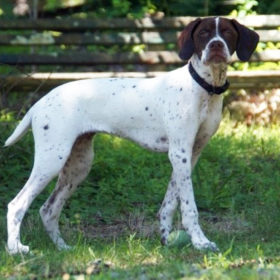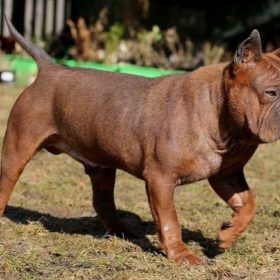Cane Corso

Representatives of the breed are great guards and protectors of the home. They are characterized by loyalty to their owner and distrust of strangers. They are focused, intelligent and severe. Always ready to rush into battle if someone close to them is in danger. They do not show aggression without reason. They do not like to bark much or loudly.
Table of Contents
Breed Information
| Another Name | Cane Corso Italiano |
| Origin | Italy |
| Height | Males 64-68 cm Females 60-64 cm |
| Weight | Males 45-50 kg Females 40-45 kg |
| Fur | Short |
| Color | Black, light gray, light red, dark red, tiger |
| Lifespan | 10-11 years |
| FCI Classification | Pinscher and Schnauzer – Molossoid and Swiss Mountain and Cattledogs |
| Group | Watchdogs, protection dogs, guard dogs |
| Price | $500-2000 |
Breed Photos
Origin History
The Cane Corso is considered one of the oldest representatives of the Molossian dogs. Their ancestors participated in gladiatorial fights in the Roman Empire.
After the collapse of the Roman Empire, dogs became popular throughout Europe. Various paintings of famous artists of that time report about it. During the Renaissance period, Cane Corso was actively depicted on engravings and photographs.
In those days, the dog was engaged in guarding and protecting herds. Also, because of their fighting qualities, dogs were good at defending farms.
World War II brought the breed to the brink of extinction. Then the scientist Giovanni Nizzoli began to restore the species actively. He sought out representatives of the breed and crossed them en masse. Soon the dog started to participate in international dog shows, and their popularity skyrocketed. Now the Cane Corso is famous all over the world.
Appearance
The Cane Corso is quite large, strong, and intimidating. Dogs have sexual dimorphism: males usually have 64-68 cm and bitches 60-64 cm. The males’ weight can be about 45-50 kg, the weight of the bitches is 40-45 kg.
The body shape of the dog is a bit stretched. Dogs look austere, elegant, and alert. They have an athletic build. The dog’s paws are strong, sturdy, and the chest is broad. The tail is usually cropped.
The Cane Corso’s coat is short, tight to the skin, a little shiny, hard to the touch. There is also a short undercoat – popular colors: black, light gray, light red, dark red, tiger. There may be a small mark on the nose, chest, and paw tips.
Character
Representatives of the breed are great guards and protectors of the home. They are characterized by loyalty to their owner and distrust of strangers. They are focused, intelligent and severe.
Always ready to rush into battle if someone close to them is in danger. They do not show aggression without reason. They do not like to bark much or loudly.
Can get accustomed to the same territory as other animals and even cats. The main thing is to grow up together since childhood.
The Cane Corso gets attached to its owner and his family very quickly. They do not like to be on their own and take it hard to be separated from their owner. They choose one owner for life, so it is advisable to bring him into the house as a puppy.
Correctly get along with children, even with babies, because they rightly sense and understand their size, never negligently hurt a child.
Care
The dog can live in the apartment and live outside the house on the property. It is not recommended to tether the dog by the kennel. It is best to put it in an enclosure.
Dogs’ fur is not suitable for cold temperatures, so it is better to take your pet indoors in winter. Corso requires a lot of physical activity, so you need to walk with him every day for at least an hour. It is advisable to comb the coat three times a week if molting – then every day. It is necessary to check the ears regularly for cleanliness and, if necessary, wipe them with a damp ear stick.
It is not advisable to bathe often, as shampoos can negatively affect your pet’s skin. Brush its teeth once a week; if its mouth is not in proper condition, you should see a doctor. After every walk, wipe his paws with a damp towel or cloth. If cracks form on the pads, they should be lubricated with vegetable oil.
Training
This breed is easy to train. They learn commands quickly and always want to make their owner proud. You should always remind them who the boss is and show them your leadership skills.
You should never shout if he doesn’t obey, change his tone of voice to a serious one. From an early age, you should train your Caney Corsa to the collar and leash.
Common Diseases
The Cane Corso has robust health and rarely gets sick if given the right care.
More often than not, they may have a common disease to large dogs: hip dysplasia. It is also worth checking the pet for allergies.
Nutrition
The health of the animal depends directly on a proper diet. It is recommended to choose natural food as the best feeding option. An adult Cane Corso eats a lot; the basis of the diet should be protein. Meat, fish, by-products, vegetables, porridges – all this the dog will eat with pleasure.
 Slovak Cuvac
Slovak Cuvac Braque Francais (Pyrenees)
Braque Francais (Pyrenees) Chinese Chongqing Dog
Chinese Chongqing Dog Anglo-Français de Petite Vénerie
Anglo-Français de Petite Vénerie Russian Piebald Hound
Russian Piebald Hound Australian Kelpie
Australian Kelpie



